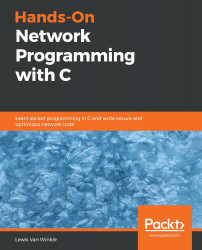As we mentioned in Chapter 1, An Introduction to Networks and Protocols, network programming is usually done using a client-server paradigm. In this paradigm, a server listens for new connections at a published address. The client, knowing the server's address, is the one to establish the connection initially. Once the connection is established, the client and the server can both send and receive data. This can continue until either the client or the server terminates the connection.
A traditional client-server model usually implies different behaviors for the client and server. The way web browsing works, for example, is that the server resides at a known address, waiting for connections. A client (web browser) establishes a connection and sends a request that includes which web page or resource it wants to download. The server then checks that it knows what to do with this request and responds appropriately (by sending the web page).
An alternative paradigm is...



